#Chinatown pawnbrokers
Text

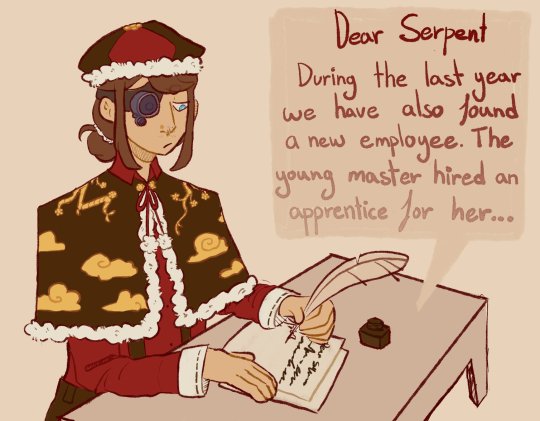
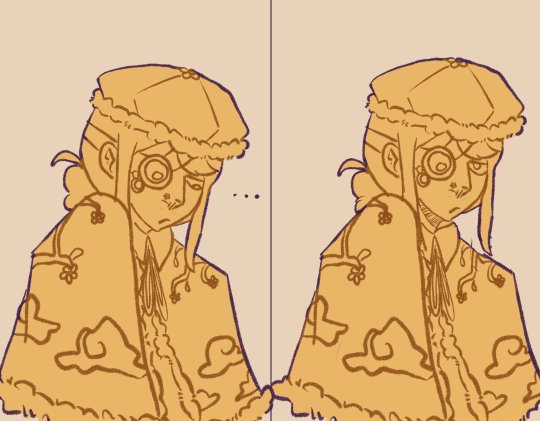
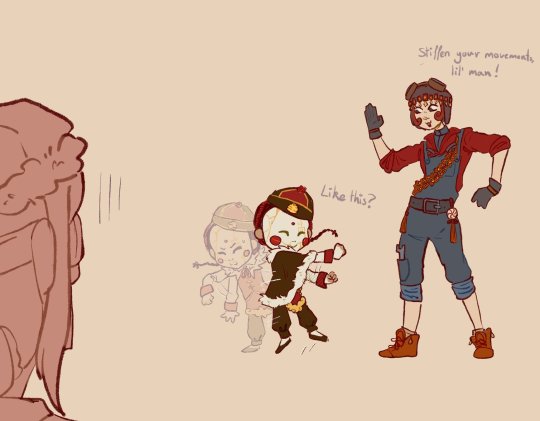
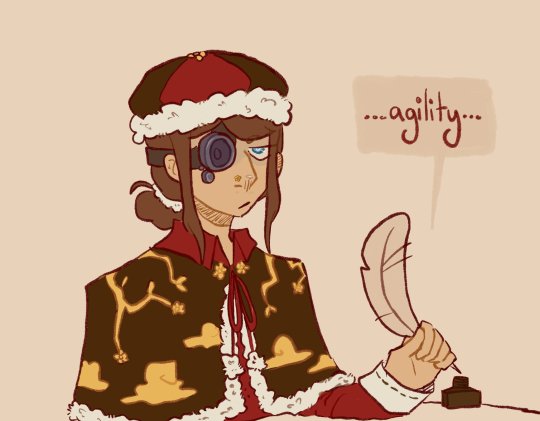
Antique Appraiser canonically letting Pawnbroker hire Tracy because her robot was cool and her dance moves were funky is my favourite part of the Chinatown lore.
#identity v#qi shiyi#edgar valden#robbie white#tracy reznik#idv#idv mechanic#idv axe boy#idv painter#idv antiquarian#idv Chinatown#ill use that tag in future dw abt it#art underdash
72 notes
·
View notes
Photo
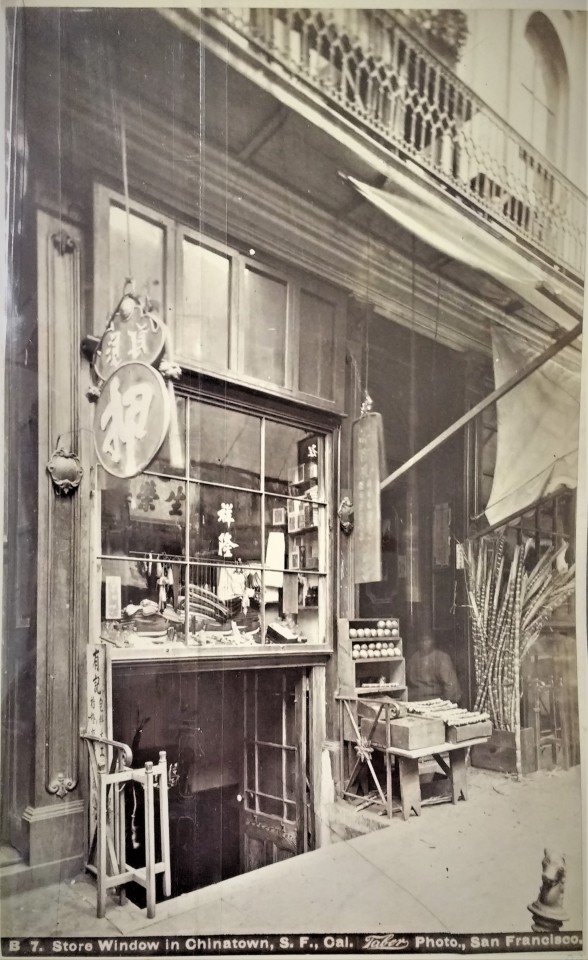
“B 7. Store Window in Chinatown, S.F., Cal.” c. 1885. Photograph by Isaiah West Taber (from the Cooper Chow collection at the Chinese Historical Society of America). The “B” designation referred to Taber Photo’s “Boudoir Photos” sold in the 5 x 8 size
The characters 祥隆 (canto: “Cheung Lung”), literally “auspicious prosperity” appear in the center pane of the storefront window. A second sign is visible inside the store, inscribed with the characters “榮生,” which, when read from right to left would be “生榮” (canto: “Saang Wing”). In the lower left-hand corner of the photo, the vertical signage for a business located in the basement appears below the lower left corner of the window display area. The name 有記 (canto: “Yow Gay”) appears, followed by what appear to the characters 包料木工枱瞪 (canto: “bau liu muk gung toy duhng;” lit. “packing woodworking table”), indicating the business of a woodworker or carpenter. The ghostly figure of a vendor can be seen in the entryway at right, presumably overseeing the small sidewalk display to the left of the store entrance. His relationship to the operators of the interior store space is not apparent. The left-center portion of I.W. Taber’s photo of a “Store Window in Chinatown” shows the prominent 押 character on the signage for a pawnshop. Typical for that era, the two-part signage of the bat hanging upside down and holding a coin is suspended from underneath the overhang of the first story’s balcony.
Pawnshops of Old Chinatown
When the Chinese pioneers began to settle in America, the appearance of pawnshops and pawnbrokers in cities and Chinatowns throughout the Pacific Coast and the western United States, became inevitable. Pawnshops, offering loans to borrowers and secured by personal property collateral, had traced their history more than three millennia to ancient China.
For lower income groups, pawnshops have, in the words of professor Heiko Schrader, “a high outreach, are very often financially viable and have several advantages, compared to other institutions of the micro financial sector. Clients cannot fall into long-term indebtedness, due to the fact that they have to deposit a pawn of at least the same value. And for the pawnshop this pawn reduces the risk to provide a loan to poor people, and monitoring is not necessary.”
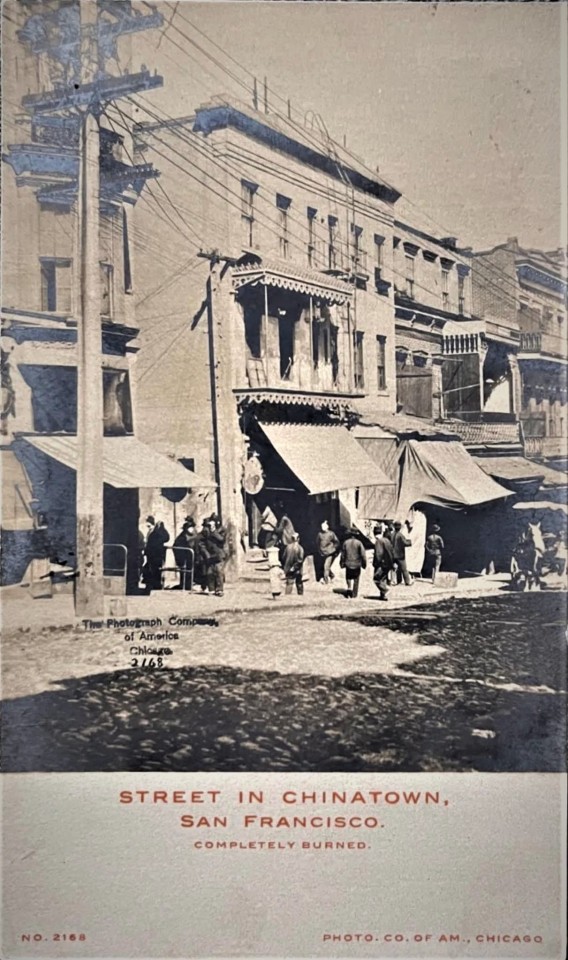
“Street in Chinatown, San Francisco. Completely Burned. No. 2168,” published c. 1906. Photographer unknown for the Photo. Co. of America, Chicago. The street is the pre-1906 pawnshop row along the north side of Washington Street at the southern entrance to Ross Alley. The pawnshop signage for the On Wing (安榮) store at 828 Washington appears in the center of the photo.
The photographic record of old San Francisco Chinatown’s streetscape provides numerous scenes of the southern Chinese pawn shop sign – the 押 character or symbol (canto: “aap”), literally a “mortgage” or pledge. Additional signage showing a bat holding a coin 蝠鼠吊金錢 (lit. “bat mouse hanging money;” canto: “fūk syú diu gām chin”), signifying fortune and the benefits denoted by the coin, can be discerned.

“The Sign of the Pawn Shop” c. 1896-1906. Photograph by Arnold Genthe (from the Genthe photograph collection, Library of Congress, Prints and Photographs Division). A print of a similar image appears in Old Chinatown : a book of pictures by Arnold Genthe with text by Will Irwin (New York : M. Kennerley, 1913, p. 195). The signage for the pawnbroker, Hang Lee & Co. (亨利押; canto: “Hung Lei aap;” pinyin: “Heng Li”) or “Pervasive Profit” pawnshop was located at 830 Washington Street near the entrance to Ross Alley, can be seen suspended in the foreground of the image. The Hang Lee pawnshop was located at 830 Washington Street, on the northwest corner of Washington Street and Stouts (or Ross) Alley – strategically situated within easy walking distance of gambling establishments and bordellos.
Historian Jack Tchen wrote in reference to Arnold Genthe’s photo “The Sign of the Pawnshop” for the Hang Lee & Co. as follows:
“Amid the gambling rooms where savings were quickly lost, pawnshops thrived. Pawnshops had very high counters upon which the item to be pawned would be place for inspection by an unseen shop worker, hidden behind the counter for security purposes. Often a man visiting his favorite prostitute or singsong girl would stop by the shop and pick up a present. [Arnold] Genthe developed his collection of jades by frequenting these stores. “
The residents of old Chinatown preferred to hold liquid assets in the form of gold or gems because of the relative ease with which they could arrange loans from pawnshops when they needed cash urgently. The neighborhood’s pawnbrokers located their shops in strategic proximity to houses of gambling and/or prostitution, with particular concentrations of shops on Washington and Jackson Streets.
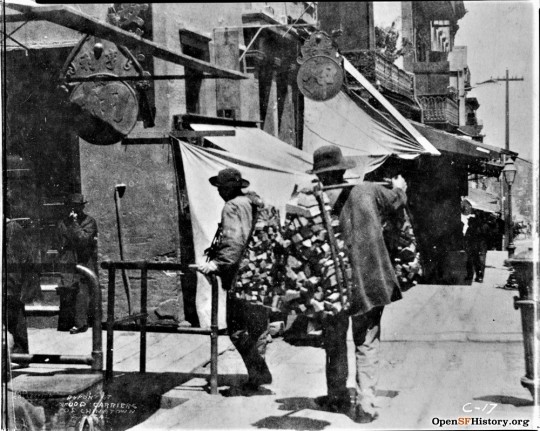
“Dupont St. Wood Carriers of Chinatown Sf Cal.” c. 1890. Photograph by A.J. McDonald (from the Marilyn Blaisdell collection). The wood carriers might have been based on Dupont Street, but the signage in the upper left-hand corner of the frame advertise the location of the Hang Lee & Co. pawnshop or “Pervasive Profit” pawnshop (亨利押; canto: “hung lei aap”), at 830 Washington Street, at the northwest corner of Washington Street and Stouts (or Ross) Alley. Also, the barely discernible signage for the On Wing (安榮) pawnshop slightly down the eastern incline of the street at 828 Washington can be seen in the upper center of the photo.
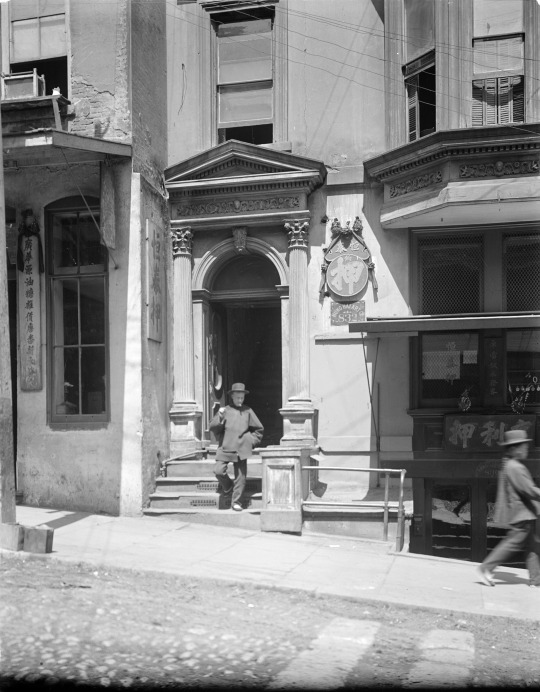
"Hung Ai[sic] Art Co. doorway, August 24, 1901.” Photograph by D. H. Wulzen (from the D.H. Wulzen Glass Plate Negative Collection (Sfp 40), San Francisco History Center, San Francisco Public Library).
In contrast to the misfortune which befell his contemporaries, the glass negatives of photographer D.H. Wulzen survived the quake and fire of 1906. As a result, the San Francisco Public Library provides higher quality images of Wulzen’s work online, such as his 1901 photo of the Hung Hai Art Co. at 832 Washington Street. Its name (恒泰) and address appear clearly in the center of the photo, as well as a prominent 押 (canto: “hung tai aap”) character emblazoned on an oversized coin topped by the usual inverted bat icon which holds the coin.
Additional confirmation of the address location on Washington Street may be found by the partially-obscured signage of its adjacent pawnshop, the Hang Lee & Co. (亨利押; canto: “hung lei aap”). The Hang Lee shop was located below street-level at 830 on the northwest corner of Washington Street and Stouts (or Ross) Alley.
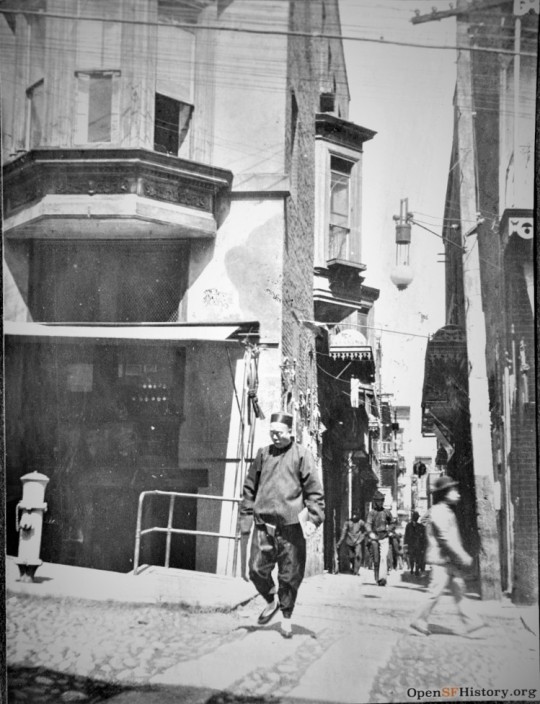
The below-street grade location of the Hang Lee & Co. pawnshop at 830 Washington Street on the northwest corner of the intersection of Washington Street and Ross Alley, c. 1900. Photograph by Henry H. Dobbin (from the Marilyn Blaisdell collection).
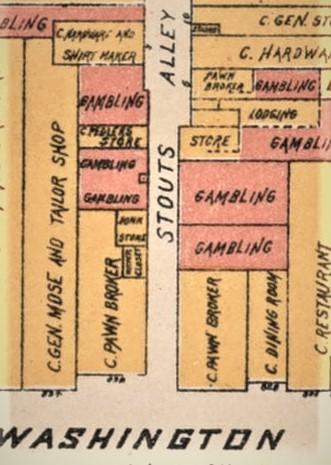
Detail of the locations of Chinese pawnbrokers’ shops on the north side of Washington Street as depicted on the San Francisco Board of Supervisors’ special committee map of July 1885 (from the Cooper Chow collection at the Chinese Historical Society of America). The address numbers of 828 (at the northeast corner of the inverse “T”-intersection and 830 (which was located below street level were omitted by the 1885 survey.

“136. Pawnbroker’s Shop, Chinatown, San Francisco, Cal.” no date. Photographer unknown, stereograph published by The Thomas Mfg. Co., Dayton, Ohio (from the private collection of Wong Yuen-ming).
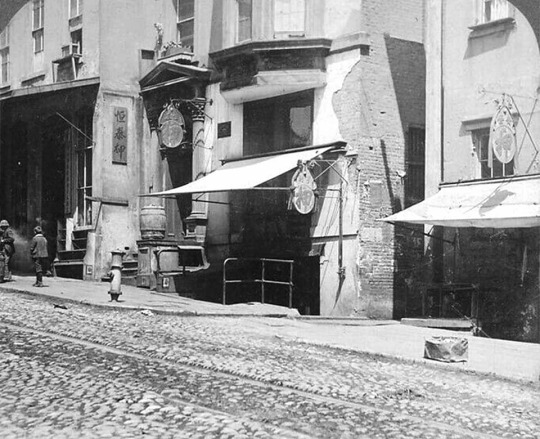
A single print (from a private collection) of the north side of Washington Street at the entrance to Ross Alley, flanked on the left by the Hung Hai Art Co. at no. 832, Hang Lee & Co. at no. 830, and, to the right of the entrance, the On Wing shop at 828 Washington Street. The trio of businesses represented a strategic and convenient cluster of pawnshops which San Francisco’s 1885 “vice map” recorded as occupying the north-side frontage of Washington extending west from Dupont Street and across Stouts (a.k.a. Ross) Alley.

The Horn Hong Company’s business calendar-directory of 1892 shows the pawnshops located in the 800-block of Washington Street, flanking the southern entrance to Ross Alley’s gambling establishments..
The 1885 map and the various business directories for Chinatown of the 1890’s show the pawnbrokers (including the Hung Hai company’s predecessor, Fong Chong Fook Kee & Co, which had occupied the 832 Washington premises during the 1880s and early ‘90s), had strategically situated themselves adjacent to, and within easy walking distance of, the gambling establishments and bordellos on Ross Alley.
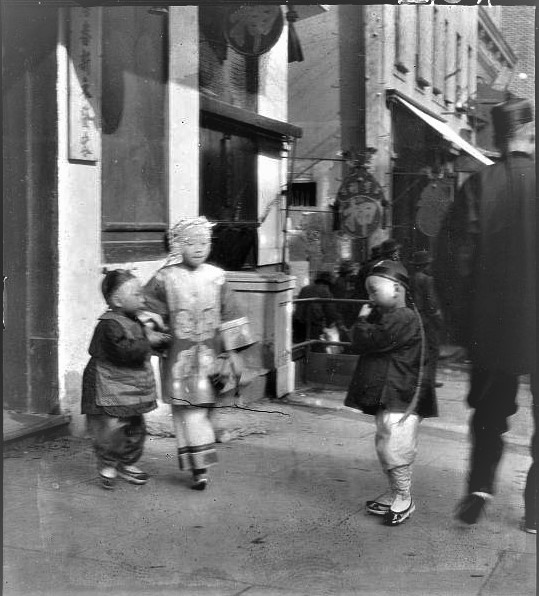
Three Children outside of the Hung Hai Art Co. pawnshop at 832 Washington Street and Ross Alley. The signage for the pawnbroker, Hang Lee & Co. (亨利押; canto: “Hung Lei aap;” pinyin: “Heng Li”) or “Pervasive Profit” pawnshop at 830 Washington Street is visible above the head of the boy in the right half of the frame. Photograph by Arnold Genthe, c. 1896 – 1906 (from the collection of the Library of Congress).

“Ross Alley Chinatown 1904.” Photograph by Henry H. Dobbin (from the collection of the California State Library). At right, the sign for the 巨興 (canto: “Geuih Hing”) or “Great Prosperity” pawnshop can be seen.
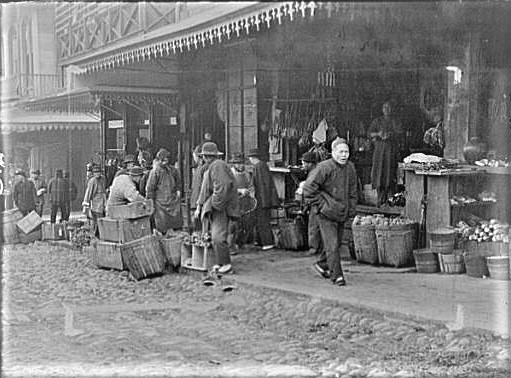
“The Morning Market” c. 1896-1906. Photograph by Arnold Genthe (from the Genthe photograph collection, Library of Congress, Prints and Photographs Division).
In the center of Arnold Genthe’s “Morning Market” photo of a Jackson Street block dominated by grocery stores, the glass windows of the Kung Wo pawnshop (公和押; pinyin: “Gunghe;” canto: “Gung Wo aap;” lit. “Honorable Peace Mortgage”) can be seen in the center of the photo at 639 Jackson Street, between the grocers Tuck Wo (德和) at 635 Jackson and Yee Chong (裕昌) at 639 Jackson.
The Chinese preferred to buy assets like gold or gems because of the relative ease with which they could arrange loans from pawnshops when they needed cash urgently. To respond to the cash demands by the dominant population of single male workers for the recreational services provided by sex workers and gambling operations, pawnshops proliferated in old Chinatown.

Detail from San Francisco’s 1885 vice map of the location of the predecessor pawnbrokerage to the Kung Wo pawnshop (公和押; pinyin: “Gunghe;” canto: “Gung Wo aap;” lit. “Honorable Peace Mortgage”) which would occupy 639 Jackson Street at the time of Arnold Genthe’s photo of the block, “The Morning Market.” The pawnshop was located at the top of the T-intersection of Jackson Street and the southern end of Bartlett Alley. The alley contained the highest concentration of Chinese houses of prostitution as depicted by the “C.P.” coding in the San Francisco Board of Supervisors’ special committee map of July 1885 (from the Cooper Chow collection at the Chinese Historical Society of America).
According historian Jack Tchen notes, “[Chinatown’s] pawnbrokers were primarily located on Jackson and Washington Streets, near the concentration of gambling rooms,” and the city’s 1885 “vice map” shows such location, as well as near houses of prostitution.

“Ross Alley, Chinatown” 1886. Oil painting by Edwin Deakin. The painting depicts a Chinese New Year’s celebration at the southern end of Ross Alley as viewed from Washington Street and the pawnshops flanking the entrance to the alleyway.
Having operated for more than three decades, Chinatown’s pawnshops were all destroyed during the Great Earthquake and Fire of 1906. However, the pawnbrokers reestablished their shops in the rebuilt neighborhood and often on familiar streets.

This post-1906 photo shows the T.G. Kong Co. pawnshop at the renumbered street address of 852 Washington Street, on the same northwest corner of Washington Street and Ross Alley.
The reminiscences of longtime Chinatown resident, Lyle Jan, about the new Chinatown’s pawnshops provide insights into how business was conducted during the era between the world wars:
“There were several pawn shops in Chinatown. I remember one in particular. It was located on the corner of Waverly Place next to Washington Street. I remember this particular pawnshop because my mother often visited this shop whenever we were short of cash.
“The pawn broker, or as he was also called, the moneylender, would provide money with interest, on personal property deposited with him as security. The pawnbroker kept the personal property until the borrower paid off his loan. Chinese gold jewelry is a personal property that can be easily pawned. The moneylender knew that if the borrower did not redeem the item, the gold jewelry would be fairly easy to sell to customers who seek a bargain on gold jewelry. The unredeemed gold jewelry is also attractive to goldsmiths who can melt the gold and make new jewelry from it.
“As a bit of added interest, during the 1930s and even up to the 40s, the street windows of pawn shops in Chinatown were boarded up so that passerbys on the street could not see the person inside the shop making a transaction. Inside the shop, the borrower faced an approximate 6 foot high counter with a wrought iron framework on the top. There was an opening in the framework much like the one for a teller in a bank. The borrower would hand the item he wanted to pawn with a raised arm and give it to the moneylender seated behind the opening of the wrought iron framework. The moneylender appraises the item to be pledged as security for the loan, then quotes the loan amount plus interest available to the borrower. If the borrower agrees to the loan terms, the money and a receipt is handed down to the borrower by the money lender. At no time was there a direct face to face contact between the moneylender and the borrower. . . .

“Customer at pawnbroker's shop remains hidden, slips camera through window for the Chinese consider it a disgrace to pawn anything”, 1944. Photograph by James Wong Howe on assignment for LOOK magazine (from the collection of the Bancroft Library).
“The reason for the boarded street windows and the high counter between the moneylender and borrower was an effort to provide privacy for the borrower during the loan transaction. It was considered a loss of face for anyone to go to a pawnshop to borrow money. This privacy bit was rather comical, in that probably more than half of the Chinatown residents have had to walk into the portals of a pawn shop for cash to tie them over temporarily, especially during the Depression Years in America. I wouldn't be surprised that when a borrower walked out the doors of a pawnshop after receiving a loan, his best friend or relative might be just walking in to pawn his or her personal property.
“There was another purpose for the high counter besides privacy. In case there was an attempted robbery, the height of the high counter would act as a physical obstacle to the robber.”
-- from China 2227 Long, Long Ago: Memoirs of Old San Francisco by Lyle Jan (Infinity Publishing.com, 2005)
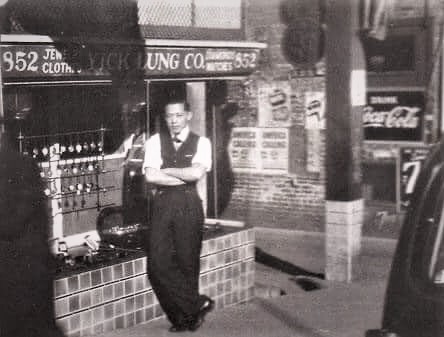
The Yick Lung Co. pawnshop operated at 852 Washington Street on the same northwest corner of Washington Street and Ross Alley as had its pre-1906 predecessor pawnbrokers. The proprietor’s name was Alexander Dea. Photographer unknown.
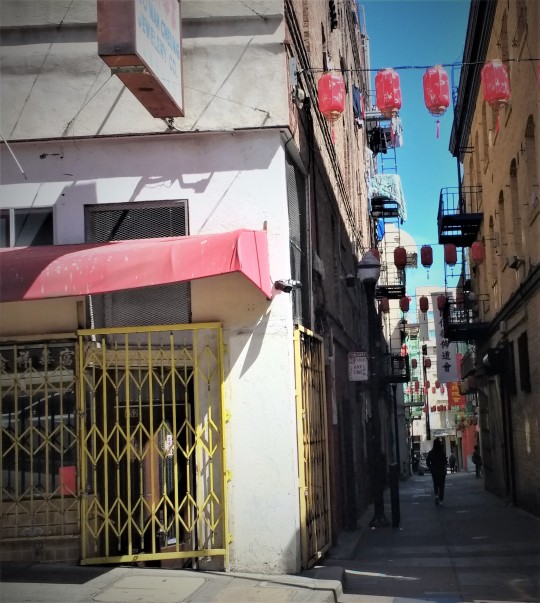
The sign of the Foo Wah Cheung hangs over the premises of 852 Washington Street at Ross Alley on June 8, 2022. Photograph by Doug Chan
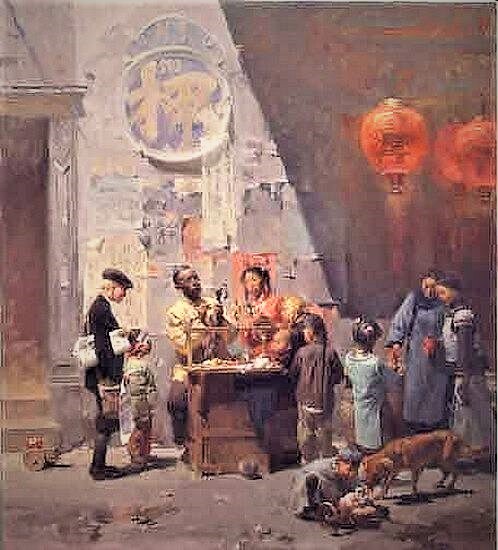
“Toymaker Off Ross Alley” Oil painting by Mian Situ. This historically-inspired painting by Situ depicts a street artist working under the faded signage of a pawnshop in front of a building façade (blending elements from the Hung Hai Art Co.’s Washington Street store frontage and the Ross Alley streetscape) from pre-1906 Chinatown. Although purporting to depict old Chinatown, the artist’s juxtaposing children with a deteriorating pawnbroker’s sign foreshadows the decline of a business sector which had served the old bachelor society and the concurrent rise of fully-formed families in the community.
With the dramatic growth of the Chinese population and families in Chinatown, the neighborhood’s once-ubiquitous pawnshops no longer play as prominent a role in the micro-economy of the once-segregated community. The pawnbrokers have faded from view, their functions assumed in large part by institutional lenders and the jewelry stores. They remain, however, an integral part of the colorful and historical past of San Francisco Chinatown’s.
youtube
“Arrest in Chinatown, San Francisco, Cal.” (c) October 25, 1897 by Thomas A. Edison, Inc., from the collection of the Library of Congress. “This film shows the arrest and conveyance of a Chinese man in Chinatown, watched by a crowd of onlookers. The precise date of this film and the arrest charge are uncertain. It is possible that the arrest was connected with the smuggling of illegal immigrants from China. By mutual agreement between China and the United States, a small quota of merchants and students was allowed to immigrate yearly, but few legal immigrants actually were of these professions, and illegal immigration continued. One of the San Francisco residences for new arrivals was located at 830/832 Washington Street, the general location from which the arrest[ed] party ascends at the start of the film. . ..” The signs of the pawnshops can be seen in the background.
#Pawnshops of San Francisco Chinatown#Chinatown pawnbrokers#Sign of the Pawnshop#Arnold Genthe#I.W. Taber#Hang Lee & Co.#Hung Hai Art Co.#On Wing#Horn Hong Company#Kung Wo pawnshop#Washington St.#Jackson St.#Ross Alley#Bartlett Alley#James Wong Howe#Mian Situ
2 notes
·
View notes
Photo
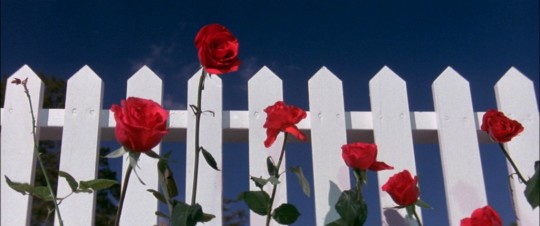
Movies I watched this week - 38
Early 60′s Sidney Lumet X 2:
✳️✳️✳️ “...You have a poet in you, but it’s a damn morbid one...”
Lumet’s 1962 powerful version of O’Neill’s stage play Long Day’s Journey Into Night. Superb ensemble performance by Katharine Hepburn, Ralph Richardson, and very young Jason Robards and Dean Stockwell.
A dysfunctional family of three drunks and a morphine fiend mother bicker and struggles with their own shortcomings, responsibilities and madness.
✳️✳️✳️ The Pawnbroker (1964), first mainstream American film to deal with the psychology of a holocaust survivor. But the combination of a bitter & lonely concentration camp survivor who became a Harlem pawnbroker, the black & Puerto Ricans stereotypes, the money as the only value left for the desperate Jew, Etc. didn’t gel. 3/10.
✴️
Udo Kier’s plays the lead in the new Swan Song, a daring & heartbreaking tear-jerker about a very old gay hairdresser, the “Liberace of Sandusky, Ohio”, who escapes his nursing home in order to style a dead woman's hair.
Beautiful! The best film of the week.
✴️
A thought-provoking documentary, I, Pastafari, about recent efforts by adherents of the Church of the Flying Spaghetti Monster (”FSM”) to be accepted as a “real”, non-satirical religion, mostly in The Netherlands and in Germany. "It is a serious offense to mock God". I found it an interesting argument on claimed faith and the nature of traditions. Long live Bobby Henderson!
R’amen!
✴️
Yves Montand X 3:
✳️✳️✳️ First re-watch in over 20 years: Claude Berri’s ‘The Water of the Hills’ stories, AKA Jean de Florette and Manon des Sources. Two classic period pieces of classic Provence-chic with Gérard Depardieu, Daniel Auteuil and Yves Montand. Deception, betrayal and revenge. 7+/10
✳️✳️✳️ First watch: Melville’s cool heist ‘policier’ Le Cercle Rouge, with Alain Delon’s glued-on porn-'stache. The ‘Red Circle’ is actually a ‘Red Herring’, as the Buddha quote in the epigraph was made up by Melville: The divergent paths of unknowing men will come together inside the Red Circle... Yeah sure.
Now, off to see Rififi...
✴️
Lennon’s Last Weekend, a Nothing documentary centered around the week-long interviews that Lennon gave DJ Andy Peebles of the BBC up until December 6, 1980, 2 days before he was killed.
✴️
2 Directed by Tony Gilroy, again:
✳️✳️✳️ “I'm Shiva, the God of death.”
Michael Clayton must be my absolute favorite film from the last 20 years. I’ve seen it 12-15 times, and it’s perfect in every sense: every single frame, or cut, the soundtrack, his son Henry’s 'Realm and Conquest' sub-plot, the horses, Monsanto’s Karen Crowder’s double-speak... Every time I’m reminded of it, I'm ‘forced’ to watch it again.
10/10
✳️✳️✳️ 2 years after Michael Clayton, Gilroy assembled many of the same players to do Duplicity: Tom Wilkinson & Denis O’Hare acting, James Newton Howard’s score, Robert Elswit DP, Etc. but this convoluted romance between two industrial spies who double and triple cross each other and everybody else is too clever, with too many complex plot twists. 5/10
✴️
Not a big David Lynch fan, and re-watching Blue Velvet for the second time after many years, I disliked it even more. The brilliant beginning, up to the discovery of the severed ear definitely signifies “This is Andalusian dog for the ‘80″. The rest of it, the sexual slavery, the masochism, voyeurism, fetishism of vintage pop songs left me completely cold.
(Photo Above)
✴️
Based on Michael Lewis’s book, The Big Short is another of my regular Guilty Pleasures housing market crash films. Because it’s about my 2004-2010 real estate investment career, and because I was there. 9/10
✴️
More about the shuttered, big American Scam, Frontline’s The Retirement Gamble. I can’t believe that for half my life I let myself live within and (somehow) accept the system. Thanks, Sammy.
✴️
“It’s the corn cubes!...”
Beatboxer Reggie Watts's A Live At Central Park (2012) - Funniest shit of the week!
(Prompt by a refresher on Metafilter.)
✴️
Sex, Lies, and Videotape, Steven Soderbergh‘s pathological debut film. It influenced me so much, I even had the same wooden cassette cases, to keep my tapes. The four then-unknown actors were all incredible. 100% mature film, not by a 26 year old pisher. The only vague, unconvincing scene is Graham opening up to Ann at the end. 9+/10
✴️
...Compared that to Bitter Moon, another late 80′s erotic ‘thriller’, Polanski’s unwatchable Merde. The man directed ‘Chinatown’ for Christ sake! Four terrible performances (including Polanski’s wife, Mariel Hemingway-lite), in a ‘daring’ exploration of ‘depraved’ sexuality. Truly awful.
1/10
✴️
2 X National Lampoon:
✳️✳️✳️ Drunk Stoned Brilliant Dead: The Story of the National Lampoon, a 2015 documentary film. I wasn’t familiar much with that history.
✳️✳️✳️ And so, National Lampoon’s Animal House - First watch. I wish I saw it 40 years ago, then maybe it would have worth a chuckle or two. As it is, it was the worst film I saw this week.
✴️
2 short documentaries:
✳️✳️✳️ Ice Ball, a short Vimeo story about Ice Harvesting in northern Minnesota.
✳️✳️✳️ The driver is red, an animated short about the hunt for Eichmann, told by an Israeli Mossad agent.
✴️
The Swarm, a new French horror movie about anthropo-entomophagy (insect eating): Blood sucking grasshoppers!
Meh.
- - - - -
(My complete movie list is here)
0 notes
Text
In my aimless internet travails, I came across this list of George Clooney’s personal favorite top 100 movies made between 1964 and 1976, which he considers the true golden age of filmmaking. It’s a solid list from the looks of it, with some pleasant surprises on there as well as a multitude of established classics. I’ve seen 35 of these films and have bolded those. Several are on my to-watch list, like Catch-22, Rosemary’s Baby, and Five Easy Pieces.
2001: A Space Odyssey (1968)
Alfie (1966)
Alice Doesn’t Live Here Anymore (1974)
All The President’s Men (1976)
Alphaville (1965)
American Graffiti (1973)
The Bad News Bears (1976)
Badlands (1973)
Bang the Drum Slowly (1973)
Blazing Saddles (1974)
Blow Up (1966)
Bonnie and Clyde (1967)
Bound for Glory (1967)
Butch Cassidy & the Sundance Kid (1969)
Cabaret (1972)
The Candidate (1972)
Carnal Knowledge (1971)
Cat Ballou (1965)
Catch-22 (1970)
Chinatown (1974)
Clockwork Orange (1971)
The Conversation (1974)
Cool Hand Luke (1967)
The Day of the Jackal (1973)
Deliverance (1972)
Dog Day Afternoon (1975)
Don’t Look Back (1967)
Don’t Look Now (1973)
Dr. Strangelove (1964)
Easy Rider (1969)
The Exorcist (1973)
Everything You Wanted to Know About Sex (1972)
Fail-Safe (1964)
Five Easy Pieces (1970)
The French Connection (1971)
The Front (1976)
The Godfather (1972)
The Godfather Part II (1974)
The Graduate (1967)
The Great Gatsby (1974)
A Hard Day’s Night (1964)
Harold and Maude (1971)
The Heartbreak Kid (1972)
High Plains Drifter (1973)
The Hot Rock (1972)
I Am Cuba (1964)
In Cold Blood (1967)
In the Heat of the Night (1967)
Jaws (1975)
Jeremiah Johnson (1972)
The King of Marvin Gardens (1972)
Klute (1971)
The Ladykillers (1955)
The Last Detail (1973)
The Last Picture Show (1971)
The Last Tango in Paris (1972)
Lenny (1974)
The Life and Times of Judge Roy Bean (1972)
Little Murders (1971)
The Long Goodbye (1973)
The Longest Yard (1974)
A Man and a Woman (1966)
Marathon Man (1976)
MASH (1970)
McCabe & Mrs. Miller (1971)
Mean Streets (1973)
Midnight Cowboy (1969)
Monty Python and the Holy Grail (1975)
Murder on the Orient Express (1974)
My Fair Lady (1964)
Nashville (1975)
Network (1976)
The Odd Couple (1968)
The Omen (1976)
One Flew Over the Cuckoo’s Nest (1975)
Paper Moon (1973)
The Parallax View (1974)
The Party (1968)
The Passenger (1975)
Patton (1970)
The Pawnbroker (1964)
The Producers (1968)
Rosemary’s Baby (1968)
Serpico (1973)
Seven Days in May (1964)
Shampoo (1975)
Sleeper (1973)
Smile (1975)
The Spy Who Came in from the Cold (1975)
The Sting (1973)
Straw Dogs (1971)
The Taking of Pelham One Two Three (1974)
Taxi Driver (1976)
The Way We Were (1973)
The Thomas Crown Affair (1968)
Three Days of the Condor (1975)
Wait Until Dark (1967)
Who’s Afraid of Virginia Woolf? (1968)
Young Frankenstein (1974)
Z (1969)
I have to wonder why The Ladykillers is in there though, seeing as it predates 1964 by almost a decade. Also there’s a huge lack of foreign films here-- but this is such a rich, varied selection in terms of genre and style (everything from My Fair Lady to A Clockwork Orange!) that I’m not going to complain. Dude’s got good taste.
8 notes
·
View notes
Photo
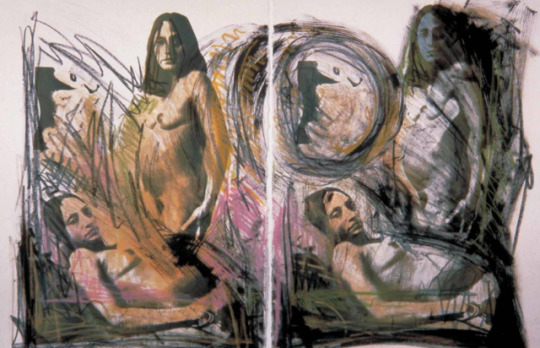
Josely Carvalho (Brazilian, b. 1942), Waiting, 1982Silkscreen and crayon on paper (diptych). 30 1/8 x 22 1/4 (76.5 × 56.5 cm) each. Courtesy of Josely Carvalho. Artwork © the artist. Image courtesy of the Hammer Museum.
Thursday, September 21–Wednesday, September 27
Thursday, September 21
Special: Signal Tide, LACMA (Miracle Mile), 9:29am.
African Masks from June Harwood Collection (Silent auction) and "Sharpener" (Faculty Exhibition), Pasadena City College Art Galleries (Pasadena), 12–1pm. Also October 13.
Artist talk: Jaime Guerrero, Skidmore Contemporary Art (Santa Monica), 4pm.
Talk: Meditation and Art—Dutch Paintings, LACMA (Miracle Mile), 4pm.
Historia Plantarum, The Huntington (San Marino), 4:30–6pm.
Dialogue: Leonard Koren and Mário Ramiro on Zines, University of San Diego (San Diego), 5:30pm.
Picturing Prince: An Intimate Portrait by Steve Parke, Mouche Gallery (Beverly Hills), 6–8pm.
Radical Women Walk-through: Beatriz Cortez, Hammer Museum (Westwood), 6pm.
Hot is Cool Summer Film Series, Palm Springs Art Museum (Palm Springs), 6pm.
BORDERS, Self Help Graphics & Art (Downtown), 7pm.
Film Night: The Mahabharata, Laguna Art Museum (Laguna Beach), 7pm.
THE PAWNBROKER / MUDHONEY, Hauser & Wirth Los Angeles (Downtown), 8–10pm.
Sorry, Atlantis: Eden’s Achin’ Organ Seeks Revenge by Asher Hartman, Machine Project (Echo Park), 8:30pm. $20–40.
Charlotte Dos Santos, Center for the Arts, Eagle Rock (Eagle Rock), 9pm. $10–15.
Art Matters Fall 2017, Santa Barbara Museum of Art (Santa Barbara), $60–75. Also September 28 and October 5, 12, 19.
Friday, September 22
The Artist Business, The Mistake Room (Downtown), 3–5pm. RSVP recommended.
Educator Open House: The Scratch and Sniff Museum, Santa Barbara Museum of Art (Santa Barbara), 4–6pm.
Ism, Ism, Ism: Experimental Cinema in Latin America, REDCAT (Downtown), 7pm. $8–10. Through September 24.
Mercado Los Olvidados, pskaufman... gallery (Downtown), 7pm. Through September 24. $10–35.
Facing, BBQLA (Downtown), 7–11pm.
Cool World, Previously Invisible To Me, and YIELD: Poems and Drawin's, Club Pro Los Angeles (Downtown), 7–11pm.
Latinas Out Loud: ¡Pa’rriba!, Hammer Museum (Westwood), 7:30–10:30pm.
Saturday, September 23
Around the Table, Long Beach Museum of Art (Long Beach), 8:30–10:30am.
Dino Fest, Museum of Natural History (Downtown), 9:30am–5pm. Continues September 24.
Flower Arranging: Succulent Wreaths, The Huntington (San Marino), 10am–12pm.
Latin American and Latinx Art Via South Bay/Long Beach Shuttle Art Tour, various locations (throughout Los Angeles and beyond), 10am–5pm. Continues September 24.
Workshop: Feeling One Self (a relational practice) with Melanie Maar, Pieter (Lincoln Heights), 11am–3pm. $30.
unDocumenta, Oceanside Museum of Art (OMA) (Oceanside), 11am–5pm.
¡Murales Rebeldes! L.A. Chicana/o Murals under Siege, LA Plaza de Cultura y Artes (Downtown), 12–6pm.
Smithsonian Magazine Presents Museum Day Live!, Pasadena Museum of California Art (Pasadena), 12–5pm.
Chakra Mapping And Art Workshop, Women’s Center for Creative Work (Frogtown), 1–5pm. $24–30.
Children’s Flower Arranging: Mini Succulent Wreaths, The Huntington (San Marino), 1–2:30pm.
ECLIPSE: A Discussion and Q&A, Art Center College of Design (Pasadena), 1pm.
Talk: From the Kilns to the Grave: Pottery from the Three Kingdoms Period of Korea, LACMA (Miracle Mile), 2pm.
From Latin America to Hollywood: Latino Film Culture in Los Angeles 1967–2017, Academy of Motion Picture Arts and Sciences (Beverly Hills), 2pm.
Marathon Sketching: En Plein Air, Pasadena Museum of California Art (Pasadena), 2–5pm.
A Woman's Place…, The William Grant Still Arts Center (West Adams), 3–6pm.
RESTORE: Modeling Alternatives to the Criminal Justice System, OCHI Projects (Mid-City), 3pm.
Billy Al Bengston: Dentos, 1965 - 1970, parrasch heijnen gallery (Downtown), 3–6pm.
Jaime Guerrero Artist Talk, Craft in America Center (Beverly Grove), 4pm.
Film: "Chocolate" and "Still Alice", LACMA (Miracle Mile), 4pm.
Robert Rauschenberg: Horsefeathers Thirteen and John Baldessari: Hands & Feet, Gemini G.E.L. (West Hollywood), 4–7pm.
LA / LA / LA, Robert Berman Gallery (Santa Monica), 5–8pm.
Artist talk: Kathy Curtis Cahill: Childhood Matters, Diane Mann: ...Continued, Carole Garland: I <3 DTLA, Elyse Wyman: Positive From Negative, TAG Gallery (Santa Monica), 5–8pm.
Alfredo Ramos Martinez and Latin American Modernism, Louis Stern Fine Arts (Beverly Hills), 5–7pm.
HANS BURKHARDT IN MEXICO, Jack Rutberg Fine Arts (Fairfax), 5–8pm.
Coastal/Border and Southbay / Long Beach Hub Opening Reception, Angels Gate Cultural Center (San Pedro), 5pm.
Frank Bowling, Marc Selwyn Fine Art (Beverly Hills), discussion with Gavin Delahunty, Senior Curator of Contemporary Art, Dallas Museum of Art, 5:30–7:30pm.
Christina Fernandez: Prospect, Gallery Luisotti (Santa Monica), 6–8pm.
Axé Bahia: The Power of Art in an Afro-Brazilian Metropolis, Fowler Museum (Westwood), 6–10pm. Opening day programs, September 24.
Skip Arnold: plus ou moins and Stephen Neidich: not necessarily necessary, ltd los angeles (Mid-City), 6–8pm.
Retna: Mano A Mano, New Image Art (West Hollywood), 6pm.
David Armacost and Nilay Lawson: Untitled, 2017, AA|LA (West Hollywood), 6–9pm.
Pedro Friedeberg: Tetragrammoebius, M+B (West Hollywood), 6–8pm.
Claire Anna Baker: Suspended Wire: Suspended Wire, Moskowitz Bayse (Hollywood), 6–9pm.
Amir H. Fallah: A Stranger In Your Home, Shulamit Nazarian (Hollywood), 6–9pm.
Jagdeep Raina, Grice Bench (Downtown), 6–9pm.
Renaud Jerez, Jenny’s (Silver Lake), 6–8pm.
Live Broadcast of Carmen, Exposition Park (Downtown) and Santa Monica Pier (Santa Monica), 7pm.
Sonorama! Latin American Composers in Hollywood, Getty Center (Brentwood), 7pm.
A Cut Above / aka In Taglio, Loft at Liz's (Mid-City), 7–10pm.
D*Face: Happy Never Ending, Kristen Liu-Wong: Conflict/Resolution, Ray Caesar, Corey Helford Gallery (Downtown), 7–11pm.
The Neutra Contemporary 2017, Neutra Institute Gallery & Museum (Silver Lake), 7–10pm.
Recuerdos de un cine en español: Latin American Cinema in Los Angeles, 1930-1960, UCLA Film & Television Archive (Westwood), 7:30pm.
Summer Happenings at The Broad: Basquiat, The Broad (Downtown), 8:30pm. $25.
Sunday, September 24
Get The Job: Résumé Crafting, Women’s Center for Creative Work (Frogtown), 9am–1pm. $48–60.
KIDS SCREENINGS: Family Flicks Film Series: Duck Soup, Hammer Museum (Westwood), 11am.
L.A. Artist Grant Opportunity Workshop, Craft in America Center (Beverly Grove), 11am–12:30pm.
City of L.A. Master Artist Workshop, Craft in America Center (Beverly Grove), 11am.
Coffee and Conversation with the Artists, Studios of Echiko & Minoru Ohira (San Gabriel), 11am–1pm.
Caribbean Festival, Museum of Latin American Art (Long Beach), 11am–5pm.
Axé Bahia Opening Day Programs, Fowler Museum (Westwood), 12–4pm.
Ruben Ortiz Torres: White Washed America, Royale Projects (Downtown), 12–5pm.
Marco Kane Braunschweiler: MONKEY, Human Resources (Chinatown), 12–4pm.
A Clay Workshop with Andres Payan, Craft and Folk Art Museum (Miracle Mile), 1–5pm. $50–60.
Jesse Benson: Miracle Grow, Michael Benevento (Koreatown), 1–3pm.
Super Workshop: Design Your Very Own Superhero, 356 Mission (Downtown), 1–5pm.
Chalk it Out, California African American Museum (Downtown), 1–3pm.
Families: On-Site: North Hollywood—Imagining the Shakyamuni Buddha Today, LACMA (North Hollywood), 1:30pm.
TOURS & TALKS: Radical Women Curator Walk-through, Hammer Museum (Westwood), 2–3pm.
Danza Azteca: Honoring the Past, Blessings for the Future, Beta Main (Downtown), 2–3pm.
China Art Gardens, China Art Objects (Highland Park), 2–6pm.
Artist Walkthrough: Lineage Through Landscape with Fran Siegel, Fowler Museum (Westwood), 3pm.
The "Minor Players" of Art History: Reassessing the Field, MOCA Grand Avenue (Downtown), 3pm.
7th Annual Beyond Baroque Awards Dinner, Beyond Baroque Literary | Arts Center (Santa Monica), 6––10pm. $60–70.
Getting Real With Money, Women’s Center for Creative Work (Frogtown), 7–10pm. $60–75
Monday, September 25
Pinch, Slab, Coil, POT! A Clay Workshop with Andres Payan, Craft & Folk Art Museum (Miracle Mile), 1–5pm.
Families: On-Site: North Hollywood—Art Workshop, North Hollywood Amelia Earhart Regional Library (North Hollywood), 2pm.
Lecture: Old 'New Media': Xerox Art in Brazil, University of San Diego (San Diego), 6pm.
Screening: Teach us All, California African American Museum (Downtown), 7–9pm.
The Isherwood-Bachardy Lecture - Isherwood, Auden, and Spender Before the Second World War, The Huntington (San Marino), 7:30pm.
Tuesday, September 26
Film: The Wiz, LACMA (Miracle Mile), 1pm.
ARTIST TALK: Rodney McMillian, Art + Practice (Leimert Park), 7pm.
Wednesday, September 27
Suzanne Lacy & Pablo Helguera at the Art, Design & Architecture Museum, UC Santa Barbara (Santa Barbara), 5–6:30pm.
Talk: Panel Discussion—The Diversity Bonus in the Knowledge Economy, LACMA (Miracle Mile), 7pm.
In Conversation: Malik Gaines and Tavia Nyong'o, California African American Museum (Downtown), 7–9pm.
SCREENINGS: Las Madres: The Mothers of the Plaza de Mayo and Después de Terremoto: Two Films by Lourdes Portillo, Hammer Museum (Westwood), 7:30pm.
1 note
·
View note